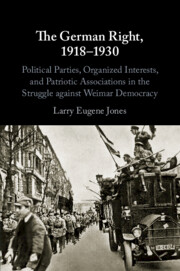 The German Right, 1918–1930
The German Right, 1918–1930 Published online by Cambridge University Press: 21 March 2020
Chapter 15 covers the period from the fall of 1928 to the summer of 1929 with particular emphasis on the resurgence of the radical Right and the quest for right-wing unity culminating in the campaign against the Young Plan. What this reveals is a heated conflict between the DNVP and Stahlhelm for the leadership of the “national opposition” that was resolved only when the latter agreed to postpone its plans for a referendum to revise the Weimar Constitution so that Hugenberg could proceed with his own plans for a referendum against the Young Plan. But Hugenberg’s efforts to unify the German Right behind his crusade against the Young Plan ran into strong opposition from right-wing moderates who denounced a provision in the so-called “Freedom Law” that threatened government officials, including Hindenburg, who were responsible for negotiating the plan with imprisonment. Hugenberg’s refusal to drop the imprisonment paragraph reflected his determination to retain the support of Hitler and the NSDAP at the risk of alienating the RLB and more moderate elements in the referendum alliance. In the final analysis, the campaign against the Young Plan did not strengthen right-wing unity but only revealed how elusive that unity was.
To save this book to your Kindle, first ensure [email protected] is added to your Approved Personal Document E-mail List under your Personal Document Settings on the Manage Your Content and Devices page of your Amazon account. Then enter the ‘name’ part of your Kindle email address below. Find out more about saving to your Kindle.
Note you can select to save to either the @free.kindle.com or @kindle.com variations. ‘@free.kindle.com’ emails are free but can only be saved to your device when it is connected to wi-fi. ‘@kindle.com’ emails can be delivered even when you are not connected to wi-fi, but note that service fees apply.
Find out more about the Kindle Personal Document Service.
To save content items to your account, please confirm that you agree to abide by our usage policies. If this is the first time you use this feature, you will be asked to authorise Cambridge Core to connect with your account. Find out more about saving content to Dropbox.
To save content items to your account, please confirm that you agree to abide by our usage policies. If this is the first time you use this feature, you will be asked to authorise Cambridge Core to connect with your account. Find out more about saving content to Google Drive.